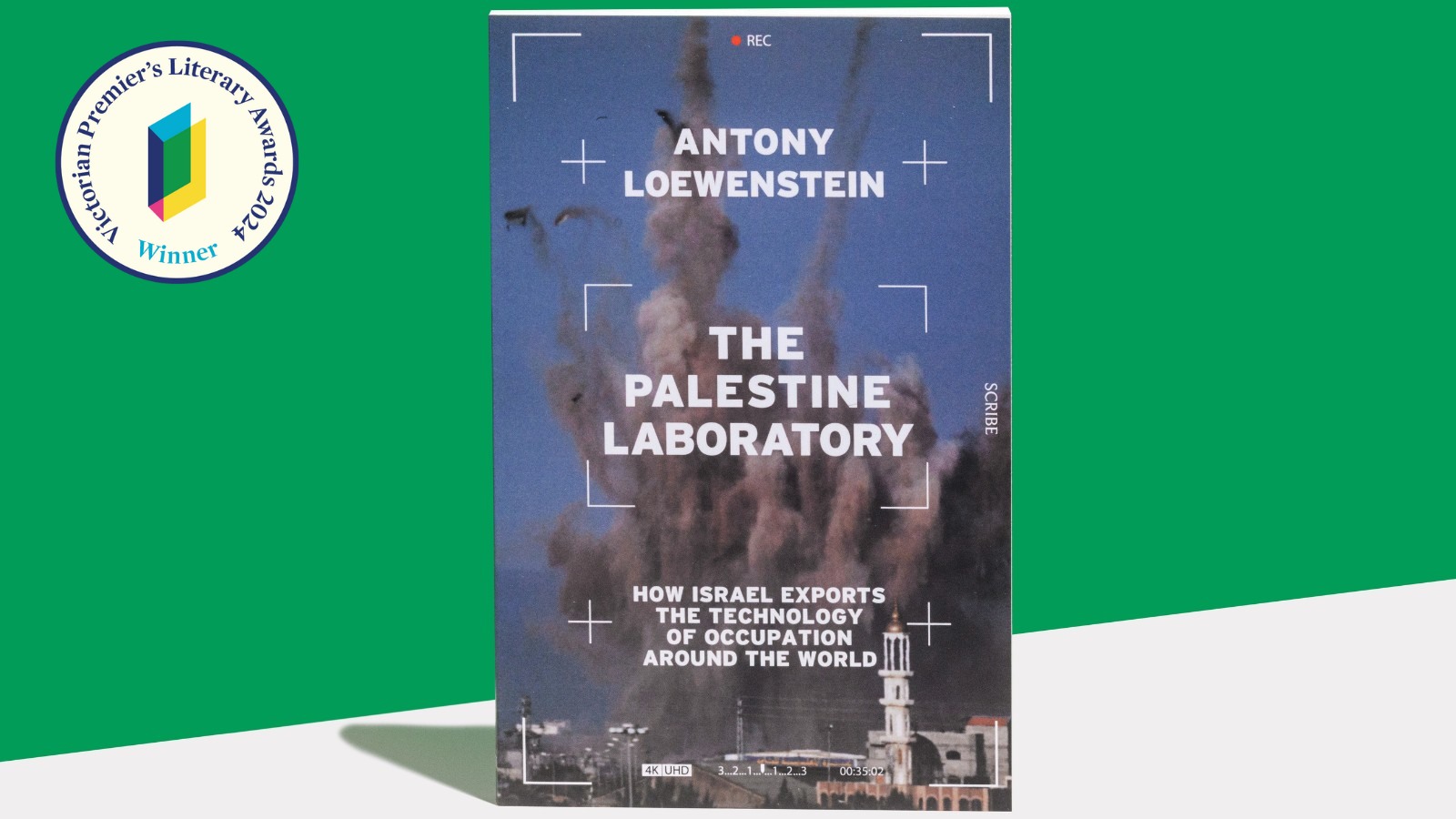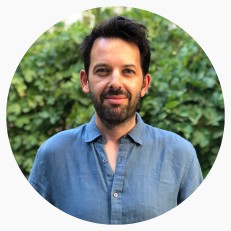VPLA 2024
The Palestine Laboratory: how Israel exports the technology of occupation around the world
Non-Fiction Shortlist

Title: The Palestine Laboratory: how Israel exports the technology of occupation around the world
Author: Antony Loewenstein
Publisher: Scribe Publications
For more than 50 years, the occupation of the West Bank and Gaza has given the Israeli state invaluable experience in controlling an ‘enemy’ population, the Palestinians. It’s here that they have perfected the architecture of control, using the occupied Palestinian territories as a testing ground for weaponry and surveillance technology that they then export around the world.
The Palestine Laboratory shows in depth and for the first time how Israel has become a leader in developing spying technology and defence hardware that fuels some of the globe’s most brutal conflicts — from the Pegasus software that hacked Jeff Bezos’s and Jamal Khashoggi’s phones, and the weapons sold to the Myanmar army that has murdered thousands of Rohingyas, to the drones being used by the European Union to monitor refugees in the Mediterranean who are left to drown.
In a global investigation that uncovers secret documents, based on revealing interviews and on-the-ground reporting, Antony Loewenstein shows how, as ethno-nationalism grows in the 21st century, Israel has built the ultimate tools for despots and democracies.
Photography by Sarah Walker
Judges’ report
Can power be measured by a state’s ability to weaponise the business of oppression? This is the timely question at the heart of independent journalist Antony Loewenstein’s latest book The Palestine Laboratory: how Israel exports the technology of occupation around the world. Loewenstein deconstructs the tools of Israel’s military-industrial complex, analysing what he describes as ‘the architecture of control’, used on Palestinians before being sold around the world to strengthen despots from Guatemala to Myanmar. Loewenstein’s global investigation exposes secret documents and details exclusive interviews that reveal the role Israel plays in spreading instruments of repression.
Extract
An edited extract from The Palestine Laboratory, written before the events of 7 October 2023:
The most effective example of separatism is the encirclement of Gaza, trapping more than 2 million Palestinians behind high fences, under constant drone surveillance, infrequent missile attack, and largely closed borders enforced by Israel and Egypt.
When Israel completed the sixty-five-kilometre high-tech barrier along the entire border with Gaza in late 2021, at a cost of US$1.11 billion, a ceremony in southern Israel took place to mark the occasion. Haaretz described the wall as “a complex engineering and technological system: the only one of its kind in the world” that required construction assistance from Europe.
Back in 2002, three years before Israeli Prime Minister Ariel Sharon withdrew nine thousand Jewish settlers from Gaza, Israeli historian Van Creveld predicted the vision: “[The only solution is] building a wall between us and the other side, so tall that even the birds cannot fly over it…so as to avoid any kind of friction for a long, long time in the future…We could formally finish the problem, at least in Gaza, in forty-eight hours, by getting out and building a proper wall. And then of course, if anybody tries to climb over the wall, we kill him.”
Gaza is now the perfect laboratory for Israeli ingenuity in domination. It is the ultimate ethnonationalist dream, keeping Palestinians indefinitely imprisoned.
The barrier around the territory was first built in 1994 and has undergone a range of upgrades since (though it was destroyed by Palestinians in 2001). Today its population has been placed in a forced experiment of control where the latest technology and techniques are tested.
However, what is happening in Gaza is increasingly occurring globally. The Palestinian architect Yara Sharif said that“the Palestinianization of cities is happening worldwide. It’s happening by destruction and erasure, but also with dramatic climate change.”
The November 2012 Israeli bombardment of Gaza, called ‘Operation Pillar of Defence’, was a seven-day war that killed 174 Palestinians and 6 Israelis and injured thousands more. While the death toll in that operation was relatively low, Israel’s ‘Operation Cast Lead’ in 2008 and early 2009 saw the death of 1,400 Gazans. That conflict saw a revolution in how the IDF portrayed the war across its multiple social media platforms.
Worried that public opinion in some Western nations was turning against Israeli military actions, the so-called “instawar” was a coordinated enterprise to live-tweet military operations and infographics, produced to proudly announce the killing of Hamas members or the arrest of Palestinian “terrorists”. These productions sometimes had the feel of a Hollywood-style, big-budget action film.
The Israeli social media strategy aimed to involve both domestic and global supporters of its military missions. By doing so, and asking backers to post their own supporting tweets, Facebook posts, or Instagram images, the IDF created a collective mission that other nations could easily mimic by stirring up nationalist fervour online.
During Operation Pillar of Defence, the IDF encouraged supporters of Israel to both proudly share when “terrorists” were killed while at the same time reminding a global audience that the Jewish state was a victim. It was a form of mass conscription to the cause through the weaponization of social media.
This was war as spectacle, and the IDF was spending big to make it happen. The IDF media budget allowed at least 70 officers and 2,000 soldiers to design, process, and disseminate official Israeli propaganda, and almost every social media platform was flooded with IDF content.
The unstated goal of the IDF information strategy is weaponizing Jewish trauma in the service of perpetuating occupation. Through countless posts and memes, the IDF believes that highlighting the sacrifices made by Israel in its never-ending battles with the Palestinians is a winning way.
In this logic, Palestinians have no right to be angry about their plight and their trauma is non-existent. Resisting the occupation is thus rendered illegitimate. This messaging ideology appeals to other nations, most of whom cannot match Israel in speed and sophistication, in their own wars with insurgents or domestic opponents. The tactic is always the same: a negative response to a badly received tweet or Facebook post is simply more posts and tweets, aiming to flood the internet with so much noise that the previous posts are quickly forgotten.
A comprehensive 2021 study of Operation Protective Edge’s social media campaign by Marisa Tramontano, a sociologist at John Jay College of Criminal Justice, found that the IDF used a multitude of visual and written tools to justify its actions in Gaza and the West Bank.
“Israel establishes itself, in part through its unmediated social media discourse, as part of the Islamophobic hegemonic coalition that positions Israel as the eastern-most front of the United States’ ‘global war on terrorism,’” Tramontano wrote.
There was hope at the birth of the digital revolution that being able to film and disseminate photos and videos of Israeli abuses in Palestine might help the Palestinian cause. There is no doubt that global awareness of the occupation has soared, and that this has been partly assisted by the raw, unedited vision of Palestinians interacting with settlers or the Israeli army.
Yet there is also a large body of evidence that hard, visual imagery has been co-opted by the Israeli state to deny the reality of what Palestinians say they are experiencing. The Israelis claim that Palestinians are lying about their circumstances despite what we’re all seeing. Being able to see Israeli atrocities against Palestinians doesn’t work with people who do not view Palestinians as human beings, a racial group who deserve punishment and death. As the Israeli population has moved to the right, moral discomfort is rare.
Israel’s social media warriors know that connecting its mission to Washington’s post-9/11 struggles is vital to eliciting sympathy and support. “The so-called threat of Palestinian terror constitutes a key component of Israeli trauma narratives—a quotidian threat layered on top of multigenerational trauma over exile and genocide,” Tramontano argued:
“More concretely, Israel’s actions are presented as moral and legal, and the state’s current plight is explained in light of Israel’s tragic past. Images of New York City burning then directly connect Israel’s military operations to the American military response to the “trauma” of 9/11. Conversely, Hamas is cast as a barbarous and irrational enemy with no legitimate claims to trauma, much like narrations about al Qaeda, the self-declared Islamic State, and the like.”
About the author

Antony Loewenstein is an independent journalist, bestselling author, filmmaker, and co-founder of Declassified Australia. He’s written for The Guardian, The New York Times, The New York Review of Books, and many others. His latest book is The Palestine Laboratory: how Israel exports the technology of occupation around the world which won the 2023 Walkley Book Award. His other books include Pills, Powder and Smoke, Disaster Capitalism, and My Israel Question. His documentary films include Disaster Capitalism and the Al Jazeera English films West Africa’s Opioid Crisis and Under the Cover of Covid. He was based in East Jerusalem 2016–2020.
Related Posts

Read
Anne-Marie Te Whiu Receives The Next Chapter Alumni Poetry Fellowship
2 Apr 2024

Read
What's on in April: Resident Organisation Round Up
28 Mar 2024

Read
Blak & Bright First Nations Literary Festival returns in 2024
7 Mar 2024

Read
What's on in March: Resident Organisation Round Up
29 Feb 2024

Read
Hot Desk Extract: International
23 Feb 2024

Read
Hot Desk Extract: The Rooms
23 Feb 2024
Share this content